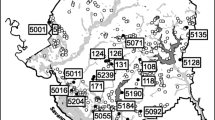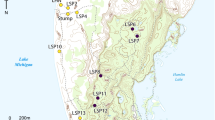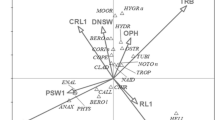Abstract
There has been recent debate about the extent to which human disturbance of the landscape affects wetland invertebrates given that the organisms are already adapted to high levels of natural disturbance. Using repeated sampling of a set of 12 temporary wetlands occurring in a differentially transformed Sand fynbos landscape in Cape Town (South Africa), we investigated patterns of macroinvertebrate and microcrustacean assemblage composition, richness and diversity in relation to a physico-chemical gradient resulting from variable habitat loss in the adjacent landscape. Both macroinvertebrates and microcrustaceans showed clear gradational changes in assemblage composition in relation to the surrounding cover of indigenous vegetation (as a proxy for habitat loss). Although the composition of assemblages appeared to be affected by this gradient of habitat transformation, no relationships were detected using various measures of taxon richness and diversity. At the small spatial scale for which patterns are analysed, the influence of natural variation on invertebrate assemblages appears to have been overridden by that resulting from habitat transformation in the adjacent landscape. Depression wetlands embedded in Sand fynbos habitat appear to be unique in terms of their physico-chemistry (acidic and rich in humic substances) and the invertebrate assemblages they support.



Similar content being viewed by others
References
Allanson, R., R. C. Hart, J. H. O’Keeffe & R. D. Robarts, 1990. Inland Waters of Southern Africa: An Ecological Perspective. Kluwer Academic Publishers, Dordrecht.
Anderson, M. J., R. N. Gorley & K. R. Clarke, 2008. PERMANOVA+ for PRIMER: GUIDE to Software and Statistical Methods. PRIMER-E, Plymouth.
Angeler, D. G. & M. Alvarez-Cobelas, 2005. Island biogeography and landscape structure: integrating ecological concepts in a landscape perspective of anthropogenic impacts in temporary wetlands. Environmental Pollution 138: 420–424.
Bagella, S., S. Gascόn, M. C. Caria, J. Sala, M. A. Mariani & D. Boix, 2010. Identifying key environmental factors related to plant and crustacean assemblages in Mediterranean temporary ponds. Biodiversity and Conservation 19: 1749–1768.
Barbour, M. T. & J. Gerritsen, 1996. Subsampling of benthic samples: a defense of the fixed-count method. Journal of the North American Benthological Society 15(3): 386–391.
Barbour, M. T., J. Gerritsen, B. D. Snyder & J. B. Stribling, 1999. Rapid bioassessment protocols for use in streams and wadeable rivers: periphyton, benthic macroinvertebrates, and fish. Report no. EPA 841-0B-99-002. U.S. Environmental Protection Agency, Office of Water, Washington, DC.
Battle, J. & S. W. Golladay, 2001. Water quality and macroinvertebrate assemblages in three types of seasonally inundated limesink wetlands in Southwest Georgia. Journal of Freshwater Ecology 16(2): 189–207.
Batzer, D. P., 2013. The seemingly intractable ecological responses of invertebrates in North American wetlands: a review. Wetlands 33: 1–15.
Batzer, D. P. & A. Ruhí, 2013. Is there a core set of organisms that structure macroinvertebrate assemblages in freshwater wetlands? Freshwater Biology 58(8): 1647–1659.
Batzer, D. P., B. J. Palik & R. Buech, 2004. Relationships between environmental characteristics and macroinvertebrate communities in seasonal woodland ponds of Minnesota. Journal of the North American Benthological Society 23(1): 50–68.
Batzer, D. P., R. Cooper & S. A. Wissinger, 2006. Wetland animal ecology. In Batzer, D. P. & R. R. Sharitz (eds), Ecology of freshwater and estuarine wetlands. University of California Press, Berkeley: 242–284.
Bilton, D. T., L. C. McAbendroth, P. Nicolet, A. Bedford, S. D. Rundle, A. Foggo & P. M. Ramsay, 2009. Ecology and conservation status of temporary and fluctuating ponds in two areas of southern England. Aquatic Conservation: Marine and Freshwater Ecosystems 19: 134–146.
Bird, M. S. & J. A. Day, 2014. Wetlands in Changed Landscapes: the Influence of Habitat Transformation on the Physico-Chemistry of Temporary Depression Wetlands. PLoS ONE 9(2): e88935.
Bird, M., J. Day & A. Rebelo, 2013a. Physico-chemical impacts of terrestrial alien vegetation on temporary wetlands in a sclerophyllous Sand fynbos ecosystem. Hydrobiologia 711: 115–128.
Bird, M. S., M. C. Mlambo & J. A. Day, 2013b. Macroinvertebrates as unreliable indicators of human disturbance in temporary depression wetlands of the south-western Cape, South Africa. Hydrobiologia 720: 19–37.
Bird, M. S., J. A. Day & H. L. Malan, 2014. The influence of biotope on invertebrate assemblages in lentic environments: a study of two perennial alkaline wetlands in the Western Cape, South Africa. Limnologica – Ecology and Management of Inland Waters 48: 16–27.
Bowd, R., D. C. Kotze, C. D. Morris & N. W. Quinn, 2006. Towards the development of a macroinvertebrate sampling technique for palustrine wetlands in South Africa: a pilot investigation in the KwaZulu-Natal midlands. African Journal of Aquatic Science 31(1): 15–23.
Bray, J. R. & J. T. Curtis, 1957. An ordination of the upland forest communities of Southern Wisconsin. Ecological Monographs 27: 325–349.
Clarke, K. R. & R. N. Gorley, 2006. PRIMER v6: User Manual/Tutorial. PRIMER-E: Plymouth Marine Laboratory, Plymouth.
Clarke, K. R. & R. M. Warwick, 2001. Change in Marine Communities: An Approach to Statistical Analysis and Interpretation, 2nd ed. PRIMER-E: Plymouth Marine Laboratory, Plymouth.
Clarke, K. R., P. J. Somerfield & M. G. Chapman, 2006. On resemblance measures for ecological studies, including taxonomic dissimilarities and a zero-adjusted Bray–Curtis coefficient for denuded assemblages. Journal of Experimental Marine Biology and Ecology 330: 55–80.
Comín, F. A. & W. D. Williams, 1994. Parched continents: our common future? In Margalef, R. (ed.), Limnology Now: A Paradigm of Planetary Problems. Elsevier, Amsterdam: 473–527.
Culler, L. E., R. F. Smith & W. O. Lamp, 2014. Weak relationships between environmental factors and invertebrate communities in constructed wetlands. Wetlands 34: 351–361.
Day, J. A. & I. J. de Moor (eds), 2002a. Guides to the Freshwater Invertebrates of Southern Africa: Volume 5 Non-Arthropods – The Protozoans, Porifera, Cnidaria, Platyhelminthes, Nemertea, Rotifera, Nematoda, Nematomorpha, Gastrotrichia, Bryozoa, Tardigrada, Polychaeta, Oligochaeta and Hirudinea. WRC Report no. TT 167/02, Water Research Commission, Pretoria.
Day, J. A. & I. J. de Moor (eds), 2002b. Guides to the Freshwater Invertebrates of Southern Africa: Volume 6 Arachnida and Mollusca – Araneae, water mites and Mollusca. WRC Report no. TT 182/02, Water Research Commission, Pretoria.
Day, J. A., B. A. Stewart, I. J. de Moor & A. E. Louw (eds), 1999. Guides to the Freshwater Invertebrates of Southern Africa: Volume 2 Crustacea I – Notostraca, Anostraca, Conchostraca and Cladocera. WRC Report no. TT 121/00, Water Research Commission, Pretoria.
Day, J. A., I. J. de Moor, B. A. Stewart & A. E. Louw (eds), 2001a. Guides to the Freshwater Invertebrates of Southern Africa: Volume 3 Crustacea II – Ostracoda, Copepoda and Branchiura. WRC Report no. TT 148/01, Water Research Commission, Pretoria.
Day, J. A., B. A. Stewart, I. J. de Moor & A. E. Louw (eds), 2001b. Guides to the Freshwater Invertebrates of Southern Africa: Volume 4 Crustacea III – Bathynellacea, Amphipoda, Isopoda, Spelaeogriphea, Tanaidacea and Decapoda. WRC Report no. TT 141/01, Water Research Commission, Pretoria.
Day, J. A., A. D. Harrison & I. J. de Moor (eds), 2003. Guides to the Freshwater Invertebrates of Southern Africa: Volume 9 Diptera. WRC Report no. TT 201/02, Water Research Commission, Pretoria.
de Moor, I. J., J. A. Day & F. C. de Moor (eds), 2003a. Guides to the Freshwater Invertebrates of Southern Africa: Volume 7 Insecta I –Ephemeroptera, Odonata and Plecoptera. WRC Report no. TT 207/03, Water Research Commission, Pretoria.
de Moor, I. J., J. A. Day & F. C. de Moor (eds), 2003b. Guides to the Freshwater Invertebrates of Southern Africa: Volume 8 Insecta II – Hemiptera, Megaloptera, Neuroptera, Trichoptera and Lepidoptera. WRC Report no. TT 214/03, Water Research Commission, Pretoria.
Eitam, A., L. Blaustein, K. Van Damme, H. J. Dumont & K. Martens, 2004. Crustacean species richness in temporary pools: relationships with habitat traits. Hydrobiologia 525: 125–130.
Euliss, N. H. & D. M. Mushet, 1999. Influence of agriculture on aquatic invertebrate communities of temporary wetlands in the prairie pothole region of North Dakota, USA. Wetlands 19(2): 578–583.
Ganguly, S. S. & L. A. Smock, 2010. Spatial and temporal variability of invertebrate communities in vernal pools on the coastal plain of Virginia. Journal of Freshwater Ecology 25(3): 413–420.
Gardiner, A. J. C., 1988. A study on the water chemistry and plankton in blackwater lakelets of the south-western Cape. PhD Thesis, Zoology Department, University of Cape Town.
Gehrke, B., A. Tshiila, M. Muasya, M. Beukes & F. Barros, 2011. Sedge diversity at Youngsfield Military Base. Veld & Flora 97: 32–33.
Gernes, M. C. & J. C. Helgen, 2002. Indexes of Biological Integrity (IBI) for large depressional wetlands in Minnesota. Minnesota Pollution Control Agency, St. Paul, MN.
Gibbs, J. P., 1993. Importance of small wetlands for the persistence of local populations of wetland-associated animals. Wetlands 13(1): 25–31.
Gittins, R., 1985. Canonical Analysis. A Review with Applications in Ecology. Springer-Verlag, Berlin,
Gómez-Rodríguez, C., C. Díaz-Paniagua, L. Serrano, M. Florencio & A. Portheault, 2009. Mediterranean temporary ponds as amphibian breeding habitats: the importance of preserving pond network. Aquatic Ecology 43: 1179–1191.
Harrison, A. D., 1962. Hydrobiological studies on alkaline and acid stillwaters in the Western Cape Province. Transactions of the Royal Society of South Africa 36(4): 213–235.
Heijnis, C., A. T. Lombard, R. M. Cowling & P. G. Desmet, 1999. Picking up pieces: a biosphere reserve for a fragmented landscape – the Coastal Lowlands of the Western Cape, South Africa. Biodiversity and Conservation 8: 471–496.
Holm, S., 1979. A simple sequentially rejective multiple test procedure. Scandinavian Journal of Statistics 6(2): 65–70.
Holmes, P., 2008. Optimal ground preparation treatments for restoring lowland Sand Fynbos vegetation on old fields. South African Journal of Botany 74(1): 33–40.
Imhoff, M. L., L. Bounoua, R. DeFries, W. T. Lawrence, D. Stutzer, C. J. Tucker & T. Ricketts, 2004. The consequences of urban land transformation on net primary productivity in the United States. Remote Sensing of Environment 89(4): 434–443.
King, R. S. & C. J. Richardson, 2002. Evaluating subsampling approaches and macroinvertebrate taxonomic resolution for wetland bioassessment. Journal of the North American Benthological Society 21(1): 150–171.
Lahr, J., A. O. Diallo, B. Gadji, P. S. Diouf, J. J. M. Bedaux, A. Badji, K. B. Ndour, J. E. Andreasen & N. M. Van Straalen, 2000. Ecological effects of experimental insecticide applications on invertebrates in Sahelian temporary ponds. Environmental Toxicology and Chemistry 19(5): 1278–1289.
Legendre, P. & M. J. Anderson, 1999. Distance-based redundancy analysis: testing multi-species responses in multi-factorial ecological experiments. Ecological Monographs 69: 1–24.
Lepš, J. & P. Šmilauer, 2003. Multivariate analysis of ecological data using CANOCO. Cambridge University Press, Cambridge.
Mahoney, D. L., M. A. Mort & B. E. Taylor, 1990. Species richness of Calanoid Copepods, Cladocerans and other Branchiopods in Carolina Bay temporary ponds. American Midland Naturalist 123(2): 244–258.
McArdle, B. H. & M. J. Anderson, 2001. Fitting multivariate models to community data: a comment on distance-based redundancy analysis. Ecology 82: 290–297.
McCallum, I. D., 1979. A simple method of taking a subsample of zooplankton. New Zealand Journal of Marine and Freshwater Research 13(4): 559–560.
McCormick, P. V., R. B. E. Shuford III & P. S. Rawlik, 2004. Changes in macroinvertebrate community structure and function along a phosphorus gradient in the Florida Everglades. Hydrobiologia 529(1–3): 113–132.
Nicolet, P., 2001. Temporary ponds in the UK: a critical biodiversity resource for freshwater plants and animals. Freshwater Forum 17: 16–25.
Ollis, D., J. Ewart-Smith, J. Day, N. Job, D. Macfarlane, C. Snaddon, E. Sieben, J. Dini & N. Mbona, 2015. The development of a classification system for inland aquatic ecosystems in South Africa. Water SA 41(5): 727–745.
Porst, G. & K. Irvine, 2009. Distinctiveness of macroinvertebrate communities in turloughs (temporary ponds) and their response to environmental variables. Aquatic Conservation: Marine and Freshwater Ecosystems 19: 456–465.
Rebelo, A. G., C. Coucher, N. Helme, L. Mucina & M. C. Rutherford, 2006. Fynbos Biome. In Mucina, L. & M. C. Rutherford (eds), The Vegetation of South Africa, Lesotho and Swaziland. South African National Biodiversity Institute, Pretoria: 53–219.
Richardson, D. M. & B. W. van Wilgen, 2004. Invasive alien plants in South Africa: how well do we understand the ecological impacts? South African Journal of Science 100: 45–52.
Rouget, M., D. M. Richardson, R. M. Cowling, J. W. Lloyd & A. T. Lombard, 2003. Current patterns of habitat transformation and future threats to biodiversity in terrestrial ecosystems of the Cape Floristic Region, South Africa. Biological Conservation 112: 63–85.
Rundle, S. D., D. T. Bilton, A. Foggo & V. Choisel, 2002. Are distribution patterns linked to dispersal mechanism? An investigation using pond invertebrate assemblages. Freshwater Biology 47: 1571–1581.
Semlitsch, R. D. & J. R. Bodie, 1998. Are small, isolated wetlands expendable? Conservation Biology 12: 1129–1133.
Silberbauer, M. J. & J. M. King, 1991. The distribution of wetlands in the South-Western Cape Province, South Africa. South African Journal of Aquatic Science 17: 65–81.
Somers, K. M., R. A. Reid & S. M. David, 1998. Rapid biological assessments: how many animals are enough? Journal of the North American Benthological Society 17(3): 348–358.
Spencer, M., S. S. Schwartz & L. Blaustein, 2002. Are there fine-scale spatial patterns in community similarity among temporary freshwater pools? Global Ecology and Biogeography 11: 71–78.
Stals, R. & I. J. de Moor (eds), 2007. Guides to the Freshwater Invertebrates of Southern Africa: Volume 10 - Coleoptera. WRC Report no. TT 320/07, Water Research Commission, Pretoria.
Studinski, J. M. & S. A. Grubbs, 2007. Environmental factors affecting the distribution of aquatic invertebrates in temporary ponds in Mammoth Cave National Park, Kentucky, USA. Hydrobiologia 575: 211–220.
Ter Braak, C. J. F. & P. Šmilauer, 2002. CANOCO for Windows Version 4.5. Biometrics – Plant Research International, Wageningen.
Theoharides, K. A. & J. S. Dukes, 2007. Plant invasion across space and time: factors affecting nonindigenous species success during four stages of invasion. New Phytologist 176(2): 256–273.
Vanschoenwinkel, B., C. De Vries, M. Seaman & L. Brendonck, 2007. The role of metacommunity processes in sha** invertebrate rock pool communities along a dispersal gradient. Oikos 116: 1255–1266.
Vicente, J., H. Pereira, C. Randin, J. Goncalves, A. Lomba, P. Alves, J. Metzger, M. Cezar, A. Guisan & J. Honrado, 2014. Environment and dispersal paths override life strategies and residence time in determining regional patterns of invasion by alien plants. Perspectives in Plant Ecology, Evolution and Systematics 16(1): 1–10.
Vinson, M. R. & C. P. Hawkins, 1996. Effects of sampling area and subsampling procedure on comparisons of taxa richness among streams. Journal of the North American Benthological Society 15(3): 392–399.
Vitousek, P. M., H. A. Mooney, J. Lubchenco & J. M. Melillo, 1997. Human domination of Earth’s ecosystems. Science 277(5325): 494–499.
Wackernagel, M. & J. D. Yount, 1998. The ecological footprint: an indicator of progress toward regional sustainability. Environmental Monitoring and Assessment 51(1–2): 511–529.
Waterkeyn, A., P. Grillas, B. Vanschoenwinkel & L. Brendonck, 2008. Invertebrate community patterns in Mediterranean temporary wetlands along hydroperiod and salinity gradients. Freshwater Biology 53: 1808–1822.
Williams, D. D., 2006. The biology of temporary waters. Oxford University Press, Oxford.
Williams, P., J. Biggs, G. Fox, P. Nicolet & M. Whitfield, 2001. History, origins and importance of temporary ponds. Freshwater Forum 17: 7–15.
Winter, M., I. Kühn, F. A. La Sorte, O. Schweiger, W. Nentwig & S. Klotz, 2010. The role of non-native plants and vertebrates in defining patterns of compositional dissimilarity within and across continents. Global Ecology and Biogeography 19(3): 332–342.
Wissinger, S. A., A. J. Bohonak, H. H. Whiteman & W. S. Brown, 1999. Subalpine wetlands in Colorado: habitat permanence, salamander predation and invertebrate communities. In Wissinger, S. A. (ed.), Invertebrates in Freshwater Wetlands of North America: Ecology and Management. Wiley, New York: 757–790.
Woodcock, T., J. Longcore, D. McAuley, T. Mingo, C. R. Bennatti & K. Stromborg, 2005. The role of pH in structuring communities of Maine wetland macrophytes and chironomid larvae (Diptera). Wetlands 25(2): 306–316.
Acknowledgments
For fieldwork assistance, we wish to thank Dr Jeremy Shelton and for help with processing invertebrate samples in the laboratory we thank Alanna Rebelo. M. Bird would like to thank the Water Research Commission and the National Research Foundation for PhD bursaries which funded this work. Permits for sampling the wetlands inside KRCA and at Youngsfield Military Base were provided by the Reserve Manager at KRCA, Ms Maya Beukes. For specialist expertise in identifying certain invertebrate taxa, we wish to thank Prof. M. Hamer, UKZN, (Anostraca); Prof. C.C. Appleton, UKZN, (Mollusca); Mr P. Reavell, Stellenbosch University, (Hemiptera and Coleoptera); Prof. M. Coetzee, Wits University, (Culicidae); Dr D. Perkins, Harvard University, USA, (Hydraenidae); Mr P. Simaka and Prof. M. Samways, Stellenbosch University, (Odonata); Prof. C. Griffiths, UCT, (Amphipoda); Dr E. Ueckerman, ARC, Pretoria, and Dr R. Gerecke, Tubingen, Germany, (Hydracarina), Mrs B Day, UCT (Chironomidae) and Dr Z Gidό, University of Debrecen, Hungary (Ostracoda). Any opinion, finding and conclusion or recommendation expressed in this material is that of the authors and the National Research Foundation does not accept any liability in this regard.
Author information
Authors and Affiliations
Corresponding author
Additional information
Guest editors: Simonetta Bagella, Dani Boix, Rossella Filigheddu, Stéphanie Gascón, Annalena Cogoni / Mediterranean Temporary Ponds
Electronic supplementary material
Below is the link to the electronic supplementary material.
Rights and permissions
About this article
Cite this article
Bird, M.S., Day, J.A. Impacts of terrestrial habitat transformation on temporary wetland invertebrates in a sclerophyllous Sand fynbos landscape. Hydrobiologia 782, 169–185 (2016). https://doi.org/10.1007/s10750-016-2804-9
Received:
Revised:
Accepted:
Published:
Issue Date:
DOI: https://doi.org/10.1007/s10750-016-2804-9




